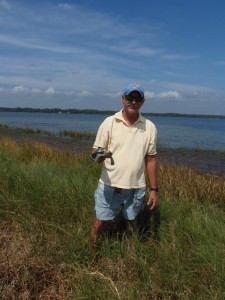When doing programs about snakes I find plenty of people who hate them… but I have never found anyone who hated turtles. I mean what is there to hate? They are slower, none of them are venomous, they have shoulders… people just like them. And to that point, when people see them crossing the road almost everyone wants to help. But that can be dangerous – for you and for the turtle. Here are couple of safety tips you should know before helping a turtle cross the road.

Photo: Molly O’Connor
Your Safety
You would be surprised by the number of people, particularly children, that are hit by cars while trying to help turtles cross the road. One story I heard involved nine-year-old girl who was riding in the backseat with her grandmother. They both saw the turtle trying to cross a busy highway and wanted to help. The grandmother pulled over to the side but before she could even get the car in park the little girl opened the door and ran into the highway only to be struck by an oncoming car. We all like turtles, and do not want to see them hit by cars, but as sad as it is to see a turtle hit – it is horrific to see the same happen to a child. No matter what your age – please watch for traffic before attempting to help a turtle.
Turtles Bite
Yep… unlike their reptilian cousins the snakes, lizards, and alligator, turtles do not have teeth… but they do have a beak. The beak is made of a hard bony like material that is blade sharp in carnivorous turtles, and serrated like a saw in herbivorous ones – both can do serious damage. Some species of turtles feed on a variety of shellfish, and if they can crush shell they can certainly do a number on your hand – so you have to be careful. First thing you should do is determine whether the turtle needs to be handled. If traffic is not too bad, or the road not too wide, you may be able to just manage traffic so the turtle can cross on its own. If you feel that you must handle the turtle, there are safe ways to hold them. Smaller turtles can be held safely from the sides by grabbing the bridge area – the portion of the shell connecting the top (carapace) to the bottom (plastron). Many turtles will begin to kick their feet when you do this and their claws may scratch – be prepared for this. There are two groups of turtles that have extended necks and your hands, grasped near the bridge of their shell, are still within range of their mouths – these are the snapping and softshell turtles. Both are notorious for their bites. So how do you handle those? Below is a short video put together by the Toronto Zoo that gives you some ideas on how to handle those situations.
https://m.youtube.com/watch?v=Lgd_B6iKPxU
Turtle Direction
Turtles cross highways for a variety of reasons – females looking for high dry ground to nest, individuals looking for more productive ponds, males looking for females – whatever the reason they are heading that way and will continue to do so. Placing them on the side of the highway where they came from will only initiate another attempt to cross. Move them to the side of the road they were heading.
The majority of turtle crossings occur during spring and summer. Untold numbers are killed each year on our highways – many gravid females carrying the next generation of the species. Though we encourage turtle conservation in Florida you do have to be smart about it. If you have any questions about Panhandle turtles in Florida contact your local extension office.
 0
0
